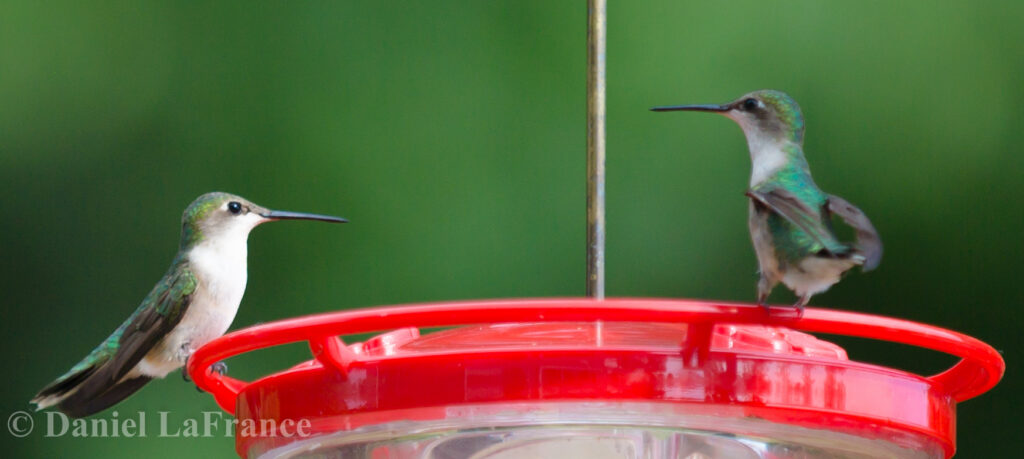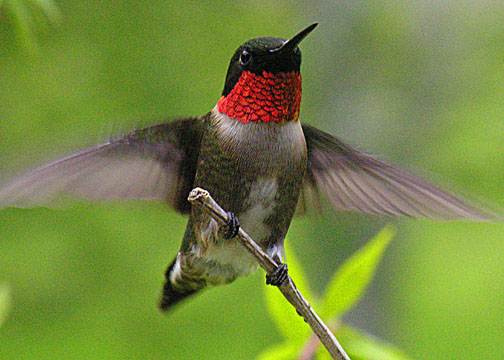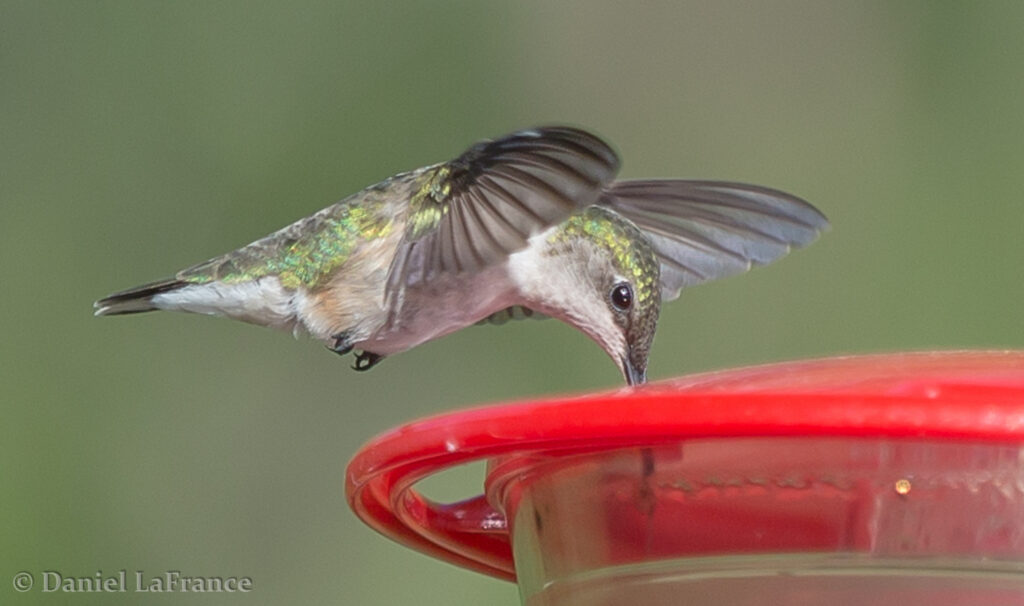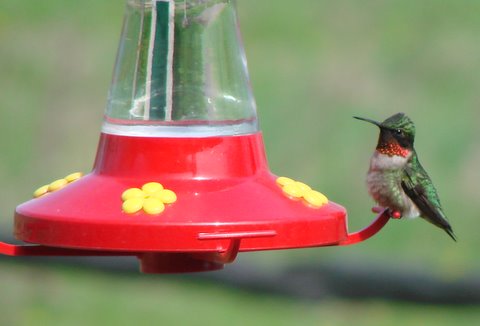Prince Edward County, Ontario, Canada
The Hummingbird Season is Here!
The hummingbird season is upon us again. Our only hummingbird species in Prince Edward County, the Ruby-throated, usually arrives by May 12th, although we have seen them arrive here as early as May 1st. Your chances of attracting a nesting pair to your premises, and enjoying their presence all summer long at your feeder, are greater if you get the feeder up early in the month.
Although there are more than a dozen species of hummingbirds in North America, we can be thankful we have only one that is common to the Bay of Quinte area. Can you imagine trying to identify more than one species of hummingbird? How many of us have had any more than a fleeting glimpse of a Ruby-throated Hummingbird as its tiny form flitted from flower to flower, rarely taking time to perch. In some parts of the western hemisphere there are numerous species of hummingbirds making identification a tedious endeavour for observers.

Although one tends to think of hummingbird feeders as a relatively new idea, these feeders have been around in some form or another since the early 1900s. The first documented attempt at attracting hummingbirds goes back to 1890 when a young girl recovering from an illness, tried holding out tubular flowers that she had filled with a sweetened solution. By using sugar, she succeeded in making daily patrons out of two male hummingbirds. About 10 years later, a Massachusetts person hung up a bottle of sugar water with an imitation trumpet creeper flower inserted in the opening. She attracted so many hummingbirds by this method it was necessary to fill the bottle twice a day. We have come a long way since then and hummingbird feeders are now available commercially everywhere.
The individuals which come to our feeder every summer are always on the go, their wings a little more than a blur. Except for the whir of the wings they are silent. Of course, hummingbirds, being somewhat anti-social, do not require an elaborate communication system that is necessary for flocking birds. While some hummingbirds in the world do sing, the ruby-throat does not have a true song, but rather, a mellow “chew”. They also have a high, drawn out distress call if under attack or handled.
A hummingbird feeder program should be underway by early May when the hummingbirds have just returned from the tropics and are actively searching for food. Any later than that means less likelihood of success. On the other hand, once they have found you, hummingbirds will continue using the feeders until fall departure. And forget the old wives’ tales that a feeder left out too long in the fall will cause a hummingbird to become dependent on you, subsequently not bothering to migrate. The migratory instinct in hummingbirds is strong and they will leave in response to hormonal changes, triggered by decreasing daylight. In Prince Edward County, this is usually by September 22nd, although sightings have been made during the first two weeks of October, and as late as October 18th (1992). In fact, it is to their advantage that the feeder is kept available to provide a good source of energy for the females and young of the year which are the last to depart in the fall.

And despite persistent folklore, hummingbirds do migrate on their own power and not nestled deep in the feathers of Canada Geese! The hummingbird myths are an interesting combination of one absurdity in conflict with another. On the one side there is the faction that believes feeding hummingbirds late in the fall will lure them into autumn frosts and sure death, while on the other side are those who maintain that hummingbirds must remain well into November for that is when the Canada Geese are actively migrating to provide the public transit that these pathetic myth mongers insist takes place.
The incredible wing beat as they hover, almost 70 beats per second, is necessary to keep the bird aloft. The smaller the bird, the faster it needs to move its wings to keep airborne.
But they have another problem too. When taking nectar from blossoms, a hummingbird must, in the absence of a convenient perch, hover while feeding, then move backwards to withdraw its long bill from the flower. In normal forward flight the body is horizontal and the wingbeat almost vertical. When the bird hovers the reverse is true – the body is vertical and the wings horizontal, the wing tip moving through a figure eight. To reverse, the wings are raised and rotated, and the hummingbird may momentarily fly on its back before rolling over. All of this performed with the wings churning the air in a blur, the bird then taking off at a brisk 50 km per hour.

Attracting hummingbirds is relatively easy. They respond more to red flowers, hence the colour of most commercially made hummingbird feeders. However, they are also attracted by orange or yellow. Of course, hummingbird feeders and flowers work hand in hand when trying to attract these birds, as hummingbirds also need small insects contained within these flowers for a balanced diet.
Although commercially prepared mixtures are available to which one can add water, and stir, a simple mixture of one part sugar to four parts water will work just as well. A stronger solution than that can cause liver damage. It is best to boil the mixture to retard fermentation and make the syrup the proper consistency. And stay away from honey as it ferments easily, causing a fatal fungus disease. Above all, replace the liquid in the feeder every few days, and keep the feeder clean. There are mixed feelings over the prepared powders that are often sold with hummingbird feeders. While its effects on hummingbirds, if any, is unknown, red dye is unnecessary and contributes virtually nothing to your efforts in attracting them, and is at best useless. Hummingbirds are attracted by the flower heads, not the nectar itself.

It is always best to choose a feeder that comes apart easily for cleaning. Droll Yankees hummingbird feeders which are the top of the line, disassemble easily for cleaning, and even come with their own cleaning brush. These top of the line feeders in both hanging and window mount designs are available from Picton Farm Supply in Picton, or The Birdhouse in Brighton, just to name a few locations in the Quinte area. Always best to invest a little extra money into a high end, well-constructed nectar feeder that will facilitate proper cleaning
Despite their additional cost, this brand of feeder is considered the best built feeder on the market today. Backed by a 100 percent guarantee against any kind of breakage, including squirrel damage, these little feeders have the added benefit of being very easy to clean. Cleanliness is extremely important in any feeder set up, even more so with hummingbirds. Nectar solutions quickly succumb to the intense rays of summer heat and will turn mouldy which can be lethal to hummingbirds. Since we recommend a thorough cleaning of the feeder and a change of liquid at least once a week, it is best to start with a small feeder, and gradually work your way up to a larger feeder as the population of hummingbird guests increases.

Your efforts to provide a nectar feeder for them just might possibly result in a pair nesting in your backyard. The nest will be tiny – barely two inches across, and it will blend in so well with the branch to which it is attached, that finding a nest will be by accident only. It will be attached to the limb with spider silk and covered with greenish-grey lichens. You might pass right by it, thinking it is only a knot on the limb, so well does it blend in. The inside of the nest will be lined with plant down, fibres and bud scales. If there are eggs inside, they will be oval in shape, only 12 mm in length and about 8 mm in width. There will be two of them. You will seldom find the nest on a search as hummingbirds will nest at heights anywhere from six to 50 feet. And don’t expect to see the male about, except perhaps relaxing on a nearby limb as it is the female that does all the work from nest building to raising the young.
For more information on birdfeeding, contact TERRY SPRAGUE